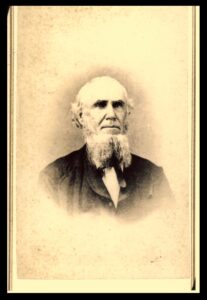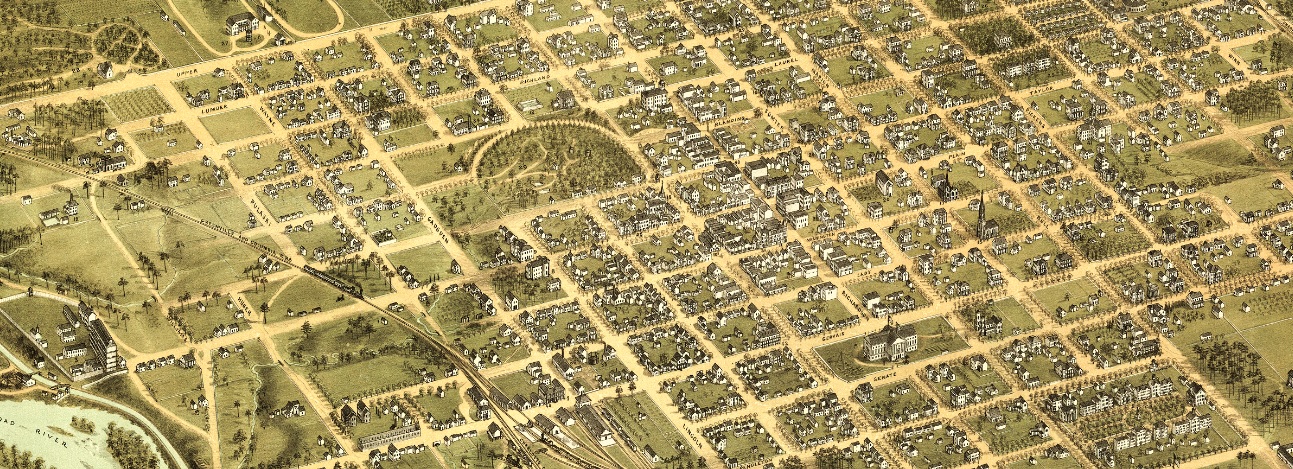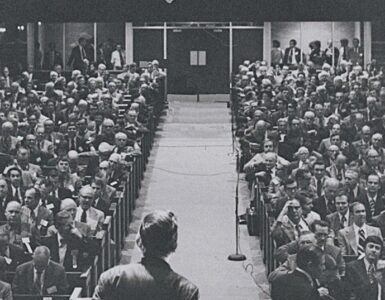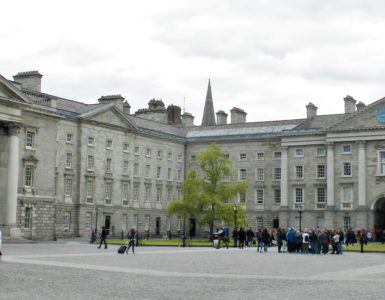 Travel in the nineteenth century could be dangerous whether by train, ship, bicycle, or horse. Trains could run off the rails and crash or collide with other trains. Ships ran aground or sank in storms and skittish horses sometimes threw off riders and bolting teams pulling carriages could lead to catastrophe for passengers. As was seen in the death of Moses Drury Hoge in his biography on Presbyterians of the Past, horse-drawn vehicles could go afoul of the latest transportation with carriages being hit by trolleys and injuring passengers. B. M. Palmer died as the result of injuries received when he was hit by a streetcar. In the case of George Howe, his fatal injury occurred after the Lord’s Day service. He was riding home when he was thrown from his carriage resulting in the breaking of one of his legs. He survived through two weeks of suffering before dying April 15, 1883. George Howe is buried in the churchyard of First Presbyterian Church, Columbia (currently A.R.P.C.). Included in his grave inscription is the comment, “Through more than fifty years a faithful minister of the Gospel.”
Travel in the nineteenth century could be dangerous whether by train, ship, bicycle, or horse. Trains could run off the rails and crash or collide with other trains. Ships ran aground or sank in storms and skittish horses sometimes threw off riders and bolting teams pulling carriages could lead to catastrophe for passengers. As was seen in the death of Moses Drury Hoge in his biography on Presbyterians of the Past, horse-drawn vehicles could go afoul of the latest transportation with carriages being hit by trolleys and injuring passengers. B. M. Palmer died as the result of injuries received when he was hit by a streetcar. In the case of George Howe, his fatal injury occurred after the Lord’s Day service. He was riding home when he was thrown from his carriage resulting in the breaking of one of his legs. He survived through two weeks of suffering before dying April 15, 1883. George Howe is buried in the churchyard of First Presbyterian Church, Columbia (currently A.R.P.C.). Included in his grave inscription is the comment, “Through more than fifty years a faithful minister of the Gospel.”
He was born in Dedham, Massachusetts, November 6, 1802, to William and Mary (Gould) Howe. His early education was accomplished through personal tutors, but when the family moved to Holmesburg, Pennsylvania, he attended a school mastered by a man named Scofield. When Scofield moved to Philadelphia, George moved there to continue his studies. Howe professed faith in Christ while attending the First Presbyterian Church of the Northern Liberties in Philadelphia. His education continued with Dr. Joshua Bates preparing him for entry to Middlebury College, Vermont. From Middlebury, he went to Andover Theological Seminary for his divinity education completing the regular course of studies in 1825, to which he added another year and a half of special studies.
In 1827, Howe accepted appointment as the Phillips Professor of Sacred Theology at Dartmouth College. He was ordained to the ministry as a requirement for both teaching and the additional duty as pastor of the campus Congregational Church. After only a few years trying to do what he believed was merely an adequate job for both duties, he resigned in frustration because of too much work and health problems caused by the severe winters.
He returned to Massachusetts where he shortly set sail for the place he would spend the remainder of his life—South Carolina. He entered the coastal state through the port of Charleston where he was soon approached about pastoring the First Scots Presbyterian Church. At about the same time of the inquiry regarding First Scots, the Synod of South Carolina and Georgia met. Rev. Thomas Golding, a teacher of theological students in Columbia, had written the synod requesting a teacher of Hebrew and Greek. Classmates of Howe at Andover in attendance at the synod meeting recommended him for the position. He accepted the offer and began duties in 1831 as the Professor of Biblical Literature at what was known at the time as the Theological Seminary at Columbia.
Dr. Howe was greatly respected for his knowledge and ministerial abilities. During his many years of ministry he was sometimes offered calls to churches seeking pastors and educational institutions looking for professors. In 1836, after only five years at Columbia, the directors of Union Theological Seminary, New York, offered him the professorship of Sacred Literature, however, Dr. Howe continued at Columbia Seminary for the remainder of his life. He was honored by his fellow elders when he was elected moderator of the General Assembly of the Presbyterian Church in the United States in 1865. He was honored with the D.D. in 1833 by the University of North Carolina during the presidency of Joseph Caldwell, and then the LL.D. was conferred in 1871 by Oglethorpe University in Georgia during the presidency of David Wills.
Howe’s single greatest literary accomplishment by far is his two-volume History of the Presbyterian Church in South Carolina published in 1870 and 1883 (more information in notes below). He was appointed by the Synod of South Carolina to be its historian in 1849. His two volumes provide a massive resource for the history of Presbyterianism in the state up to 1850 and they constitute the most extensive historical study of the development of American Presbyterianism in a single state ever published. Howe brings out the uniqueness of the state’s Presbyterian and Reformed influences by telling the history of Scotch and Scotch Irish immigrants that founded American Presbyterian (i.e. PCUSA) and Associate Reformed congregations that settled in the Upstate; the persecuted French Reformed exiles called Huguenots that prospered as pioneers in Charleston and the Lowcountry; and the Covenanters that settled in the northern Midlands. It seems odd that since Howe obtained his call to Columbia Seminary because of his skill with the languages of Scripture that he is known for publications concerning church history. One of his students that was gifted with languages who died at a young age was remembered in a memorial sermon by Howe, see “Robert Means, 1796-1836.”
George Howe was married twice during his long life. His first marriage was August 25, 1831 to Mary the daughter of Rev. Jedediah Bushnell, but she lived a little more than a year after their wedding before passing away, possibly as a result of complications from childbirth. December 19, 1836, George and the widow Sarah (Walthour) McConnell from Walthourville, Georgia, were married; she survived Dr. Howe by two years passing away April 14, 1885. The Howes had five (possibly six) children: George, Walthour, William, Sarah Emily (possible two people), and Marion Louisa. Given the many years of teaching, it is interesting that so little is known about his life and work.
Barry Waugh
Notes— The header provides a section from the Library of Congress online collection map titled, “Bird’s eye view of the city of Columbia, South Carolina 1872”; First Church is in the right center with the tall steeple and nearly straight up from it is a block with grounds and a three-section building that was Columbia Seminary. The Howe house was at the time being renovated from use as an office when I first located it. Even though its location was within the wide swath of fire that consumed areas of the city during Sherman’s burning of Columbia, the house was spared. The home is diagonally across from what is currently known as the Robert Mills House, which was the campus of Columbia Seminary for many years until it moved to Decatur, Georgia. Dr. Howe’s most extensive work, History of the Presbyterian Church in South Carolina, By George Howe, D.D., Professor in the Theological Seminary, Columbia, South Carolina. Prepared by Order of the Synod of South Carolina, 2 vols., (vol. 1, Columbia: Duffie & Chapman, 1870, vol. 2, Columbia: W. J. Duffie, 1883), was reprinted by the Synod of South Carolina of the Presbyterian Church in the United States, vol. 1, 1965 and vol. 2, 1966. For a bibliography of Howe, a transcription of his An Appeal to the Young Men of the Presbyterian Church in the Synod of South Carolina and Georgia (1836), and an article titled, “The Ministerial Shortage Problem in Presbyterian History & George Howe’s Appeal for More Ministers,” see The Confessional Presbyterian 4, 2008, pages 43-71. The biographical information regarding Howe was taken from the memorial for him found on pages 22-23 of the Minutes of the Synod of South Carolina, at its Annual Sessions at Anderson, S.C., Oct. 24, 25, 26 and 27, 1883; from the Memorial Volume of the Semi-Centennial of the Theological Seminary at Columbia, 1884; and from David B. Calhoun, Our Southern Zion: Old Columbia Seminary, 1828-1927, Banner of Truth, 2012. The elusive information about his honorary degrees was located in Catalogue of Officers and Students of Middlebury College in Middlebury, Vermont, and of Others who have Received Degrees, 1800-1915, Middlebury, 1917, page 64. The portrait of Dr. Howe is a copy of a CDV (carte de visite, i.e. calling card) provided courtesy of the PCA Historical Center, St. Louis, Missouri, Wayne Sparkman, Director.





